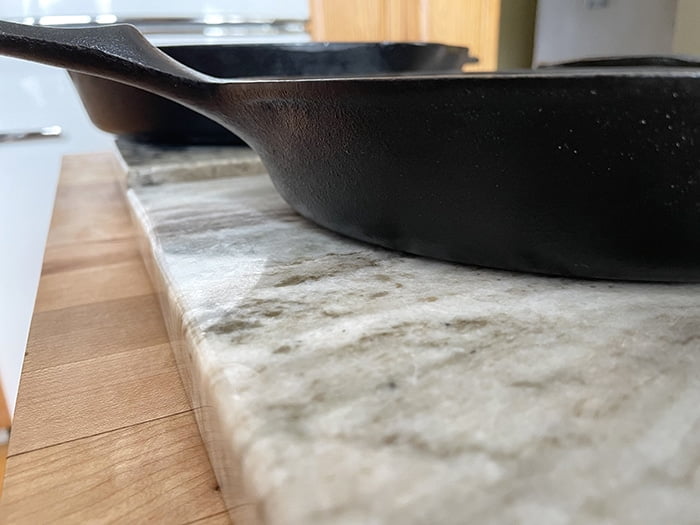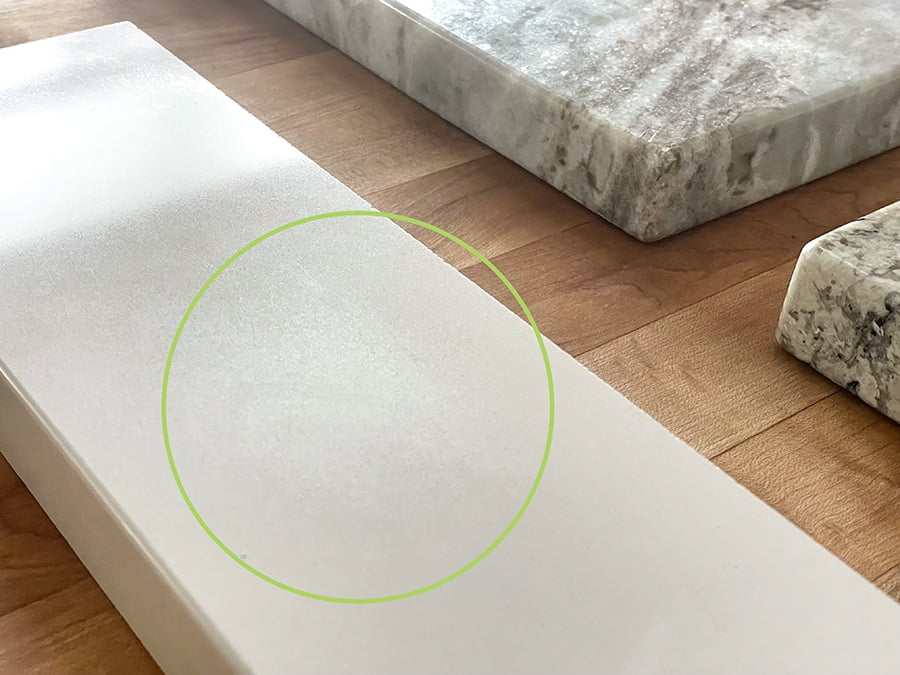Stone countertops, how durable are they really? (If you missed “Part One: Stains”, check it out here!)
Full disclosure: I don’t personally have stone countertops (yet), so these stress tests are as much for me as they are for you! I’ve heard a lot about the beauty and durability of stone countertops and before I make the investment, there are things I want to know. I love to cook, and do it a lot, so as a result I tend to be pretty hard on my kitchen. If I’m going to invest in a quality product, I want to be sure it will stand up to my lifestyle.
With than in mind, I beat up some stone so you don’t have to! Keep reading to see what I discovered.


Hot Pots and Stone Surfaces:
While we generally don’t recommend that you put hot pots and pans directly on stone surfaces, I was curious. Since I was already re-seasoning my cast iron collection, I figured I’d see what happened. I started at an average 350F, and once my pans were up to temperature, I took them out and set them on my stone samples for about 10 minutes. Once they’d cooled off, I bumped the temperature in the oven and did the same thing in 50 degree increments all the way up to 500F.

My Observations:
Don’t put hot pots onto quartz. While there were no scorch marks or any change in colour from the heat, the sheen on my quartz sample definitely changed, right from the first contact. To be fair, my quartz sample was basically entirely white, and while it might not be terribly noticeable on a variety with more colour variation or speckling, in the right lighting the damage to my sample was very obvious. It makes sense, since quartz countertops are made by mixing quartz dust and chips with a resin. While the quartz itself is pretty resilient, it’s hard to know exactly how the resin will react.
Granite is seemingly impervious to heat. I was impressed by how hot I could get the pans and that the granite samples held up perfectly. There was no change to the look, sheen or texture of the granite at all. That said, granite is a natural material and as with all natural materials, there is always the possibilities of weak spots and flaws in the stone itself. Extreme hot to cold fluctuations can wreak havoc on a lot of seemingly indestructible materials, and finding a trivet is probably a small price to pay to maintain your granite countertops. However, knowing that I won’t ruin the surface if I find myself in a position where I NEED to put something hot down right away (which would most definitely happen with laminate)… that’s reassuring.

Impact and Stone Surfaces:
The kitchen is full of pointy bits and heavy things, so how does stone stand up to those of us with (sometimes literal) butterfingers? Thinking back about things I’ve dropped on my countertops, by far the majority of them would have shattered before causing any damage at all to the stone. Have you ever had that feeling when you’ve dropped a glass or a dish and been so relieved that it didn’t break? That feeling doesn’t happen with stone countertops. There’s no give in the slightest and zero forgiveness for a fumble.
In my tests, I decided not to drop any of my dishes (for obvious reasons) so I grabbed a handful of tools and took out some post-spring-break stresses. I dragged, dropped and hammered to see what the stone could take and what it couldn’t.

My Observations:
It’s probably best to not intentionally beat up your stone.
The corners are definitely the most vulnerable. It didn’t take much of a swing from a hammer to chip them. I dragged rough, heavy cast iron across the surface with no damage, but pulling it over a corner left a mark. Same with dropping things, unless the item I dropped had a point that hit the surface first, both the granite and the quartz held up fairly well, but dropping heavy items on the corners almost always resulted in a chip.
To be fair… almost none of what I did to beat up the stone samples would be considered normal activity, even in a hard-working kitchen like mine, but I learned a few things will help me make decisions when I decide to upgrade my kitchen countertops.

1. Protect the corners. Personally, I would opt for a drop-in sink in my own kitchen. The edge around the sink would take the brunt of the action, and would be the first place I’d see damage. As much as I love the look of an undermount sink, I know what I put my kitchen through, and would want to protect that edge as much as I could.
2. Stone Countertops are one of the most durable surfaces I’ve ever used in a kitchen. Wood butcherblock can be fixed more easily, but it also damages more easily. While laminate counters are generally pretty good with impact resistance, there’s no chance I wouldn’t have melted a hole in them with the first hot pan. The only countertop surface I can think of that would rival stone is stainless steel, but scratches are pretty common with metal and there aren’t many people who would like something that industrial in their home kitchen.

There is no countertop surface that is indestructible, but stone comes pretty close and with care the beauty of stone countertops will last for decades. (Also, it’s important to know that if you do fumble something, stone CAN be patched, just call us and we can help!).
When deciding what kind of countertops you’d like in your new kitchen or kitchen renovation, take a good hard look at how you’re planning on using your space, and choose the surface that suits it best. If you’d like some more information, check out our blog post on caring for your stone countertops or the one that answers many of our frequently asked questions.
If we’ve sparked your interest and you’d like to bring stone home, contact us! We’d love to help.

